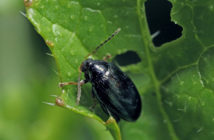Output-enhancing, yield-protecting and agronomy-improving traits in modern OSR hybrids provide UK growers with some of the best ways of meeting today’s particular production challenges, believes leading oilseed rape breeder, Matthew Clarke.
Amongst the most valuable of the advanced genetic characters available, he identifies high oleic, low linolenic (HOLL) oil, robust disease and pod shatter resistance, vigorous early crop development, low biomass and Clearfield.
“Hybrid HOLL breeding has allowed us to completely eliminate any gross output deficit with the best of ordinary double lows,” Matthew Clarke explained. “Together with current rapeseed values, this makes the flat rate premiums of HOLL growing on contract especially attractive.
“Alongside double phoma/stem canker resistance, the scale and quality of the resistance to light leaf spot we now have in the likes of DK Extrovert, DK Explicit, DK Exalte and DK Exentiel allows the greatest overall flexibility in fungicide choice, usage and timing while providing the best insurance against changing fungicide sensitivity and weather restrictions on spraying.
“Equally valuable insurance against the weather comes from the pod shatter resistance in all our DK hybrids,” he added. “Their solid genetic protection from the serious yield losses and volunteer problems that can easily arise from seed shedding around harvest is a real boon; not least in reducing the need for pod sticking sprays and enabling the harvest to be timed for the highest yields and oil contents.”
Alongside these output-enhancing and yield protecting opportunities, Matthew Clarke urges growers to make the most of key agronomic traits to improve OSR performance consistency, economy and manageability.
“The vigorous, fast early development of our rapid hybrids provides excellent insurance against delayed sowing, difficult seedbeds, poor autumn weather and early pest, disease, nutrition and weed challenges,” he stressed. “Their superior ability to develop green area ahead of stem extension offers valuable savings in spring N for canopy development too.
“At the other end of the scale our low biomass hybrids with the semi-dwarf character are ideal for the earliest drilling and highest fertility sites as they’re virtually impossible to lodge.
They’re every bit as vigorous as their taller cousins, extremely winter hardy and have lower spring canopy development needs than most.
“We also now have Clearfield (CL) varieties with similar levels of gross output to mainstream double lows for the most effective in-crop control of charlock, runch and hedge mustard as well as non-CL rape volunteers.”


